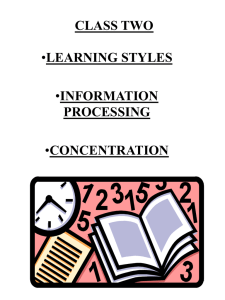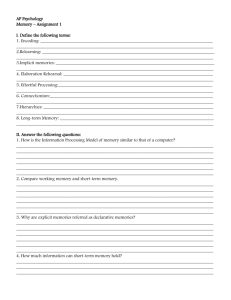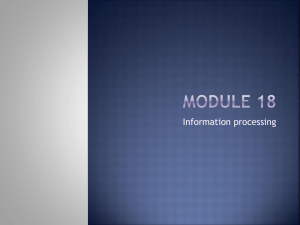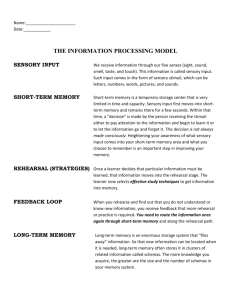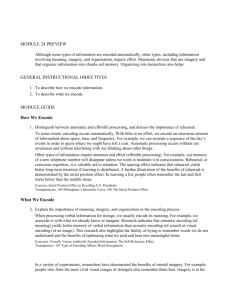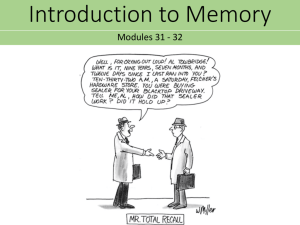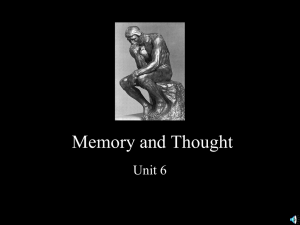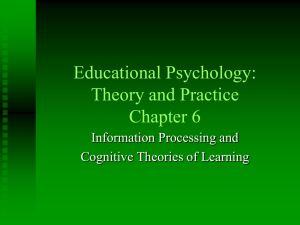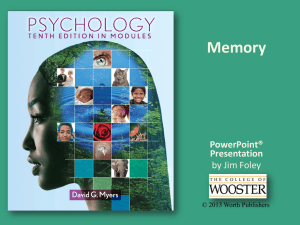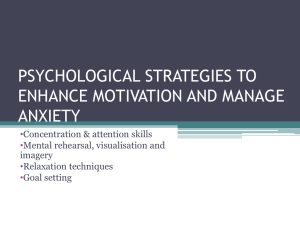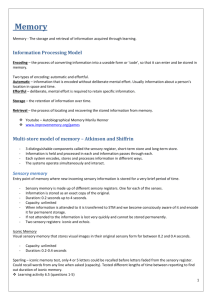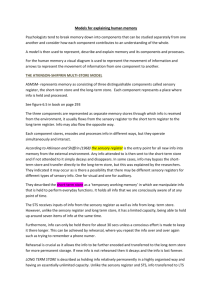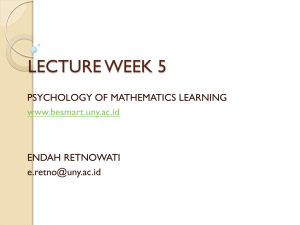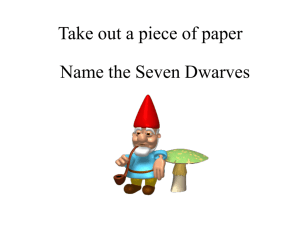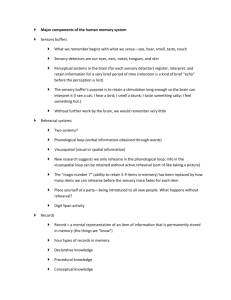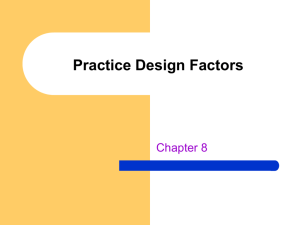Memory Name Period Mrs. Marler Psychology What is memory
advertisement
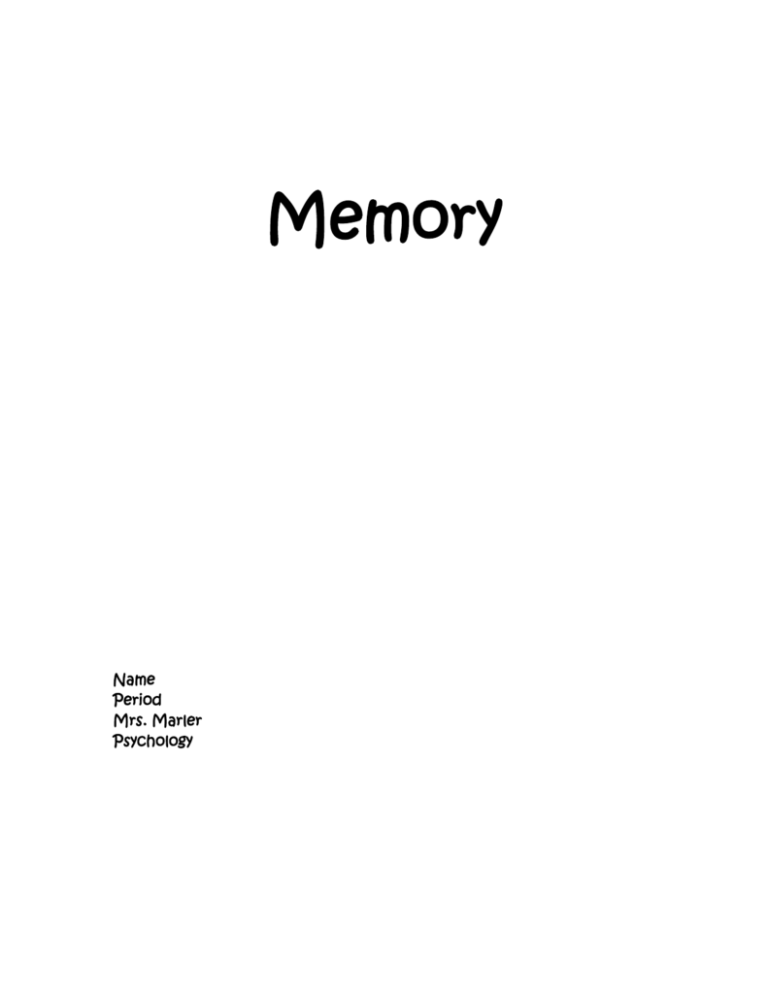
Memory Name Period Mrs. Marler Psychology What is memory? Memory is learning that lasts. It involves three steps: 1. Encoding of information 2. Storage of information 3. Retrieval of information Terms you need to know: Encoding: The processing of information into the memory system. Storage: The retention of information over time. Retrieval: The process of getting information out of memory storage. Sensory memory: The immediate, very brief recording of sensory information into the memory system. Short-term memory: Activated memory that holds a few items briefly. Long-term memory: The relatively permanent and limitless storehouse of the memory system. Includes knowledge and skills, and experiences. Working memory: Short-term memory that involves conscious, active processing of incoming auditory and visual-spatial information and of information received from long-term memory. Memory Theories Atkinson- Shriffrin classic Three Stage Model of Memory This is an older but historically significant model of memory formation. This model explains memory as: 1. We take in information through sensory memory and we record some and forget the rest. 2. From sensory memory we process information into short-term memory where we encode it through rehearsal. 3. From short-term memory some of the information that has been rehearsed will go to long-term memory and the remainder will be forgotten. Modified version of Three-stage processing model of memory Major differences from the Akinson-Shiffrin Three Stage Model: 1. Some information goes straight to long-term memory without processing and at times even conscious awareness. This means that the information skips stage 1 and 2. 2. Since we cannot focus on all the sensory information received, we select information that is important to us and actively process it into our working memory. The information that we rehearse and use in problem solving will go into long-term memory. ENCODING After learning basic skills the brain has the ability to parallel process, allowing people to take in many pieces of information simultaneously. The processing that occurs with out you thinking about it is called automatic processing. People record information such space, time and frequency automatically. Fore example they may remember where they have been in a familiar building, where on a page they left off or how many times they had to go to there car to get something without thinking about it. Effortful processing is processing that requires attention and conscious effort. It often produces lasting memories. This includes processing meaning, imagery, and organization. Automatic versus Effortful Processing Examples Automatic Effortful 1. Where you ate dinner last night 1. Remembering a recipe 2. Where you left your coat 2. Navigating a mall the first time 3. Driving 3. Learning to drive 4. What a word means 4. Learning a new word Rehearsal is the conscious repetition of information, either to maintain it in consciousness or to encode it in storage. - Rehearsal helps people to remember information. Without rehearsal most information is lost quickly. - Spacing out rehearsal over time helps to improve memory. This is called spacing effect. For example studying vocabulary words every weeknight for ten minutes is a more effective technique than studying vocabulary words for thirty minutes on one evening. “Spaced study beats cramming.”(Myers 257) - Serial position effect also impacts people when studying a list. People tend to remember the first and last items in a list better than the items in the middle. TECHNIQUES FOR ENCODING MEANING 1. 2. 3. 4. 5. 6. 7. spacing rehearsal making connections context rephrasing imagery organization a. chunking b. hierarchies 8. mnemonic devices Making connections: We hear things we usually try to connect the information with information that we already know. We also use context to interpret the meaning. This is an example of working memory interacting with long-term memory. Context: Having context helps with remembering. For example having the general topic of a passage you are reading, knowing the author or purpose of the writing all may help with remembering the passage. Rephrasing: Research has shown that taking information and putting it into your own words helps with learning. “ The amount remembered depends both on the time spent learning and on our making it meaningful.” (Myers 258) imagery: It is easier to remember visual images or words that readily spark a visual image. Imagery is mental pictures. Vivid images are the most likely to remain in memory long-term. Mnemonic devices: These are memory aids. They often use vivid imagery and organizational devices. 1. Peg-word system: use a jingle to remember things. a. “One is a bun; two is a shoe; three is a tree; four is a door; five is a hive; six is sticks; seven is heaven; eight is a gate; nine is swine and then is a hen.” ( Myers 259) i. When trying to remember a list this helps with making things visuals. For example if you are trying to remember what to bring to school associate each thing with the visual and it will help you remember. 1. Example: Eat a bun while picking up my backpack. Tie my shoes and check for my books. Get my pens so I don’t have to tell the teacher I left it in a tree…etc. 2.Acronyms: you make up words with each letter representing something to be remembered. b. Roy G. Biv –helps remember colors of the rainbow Red, Orange, Yellow, Green, Blue, Indigo, Violet 3. Make a song or rhyme: Creating a song can help with memory. A famous example is “Thirty days hath September, April, June, and November; All the rest have thirty-one, Save February, with twenty-eight days clear, And twenty-nine each leap year.” Organization: Taking information and organizing it can help with later retrieval. 2. Chunking- organizing items into familiar, manageable units help with memory. a. This often happens naturally. Ex: words or phrases b. Grouping things can help with memory. 3. Hierarchies – Taking concepts and grouping them from broad terms and narrowing them down.

